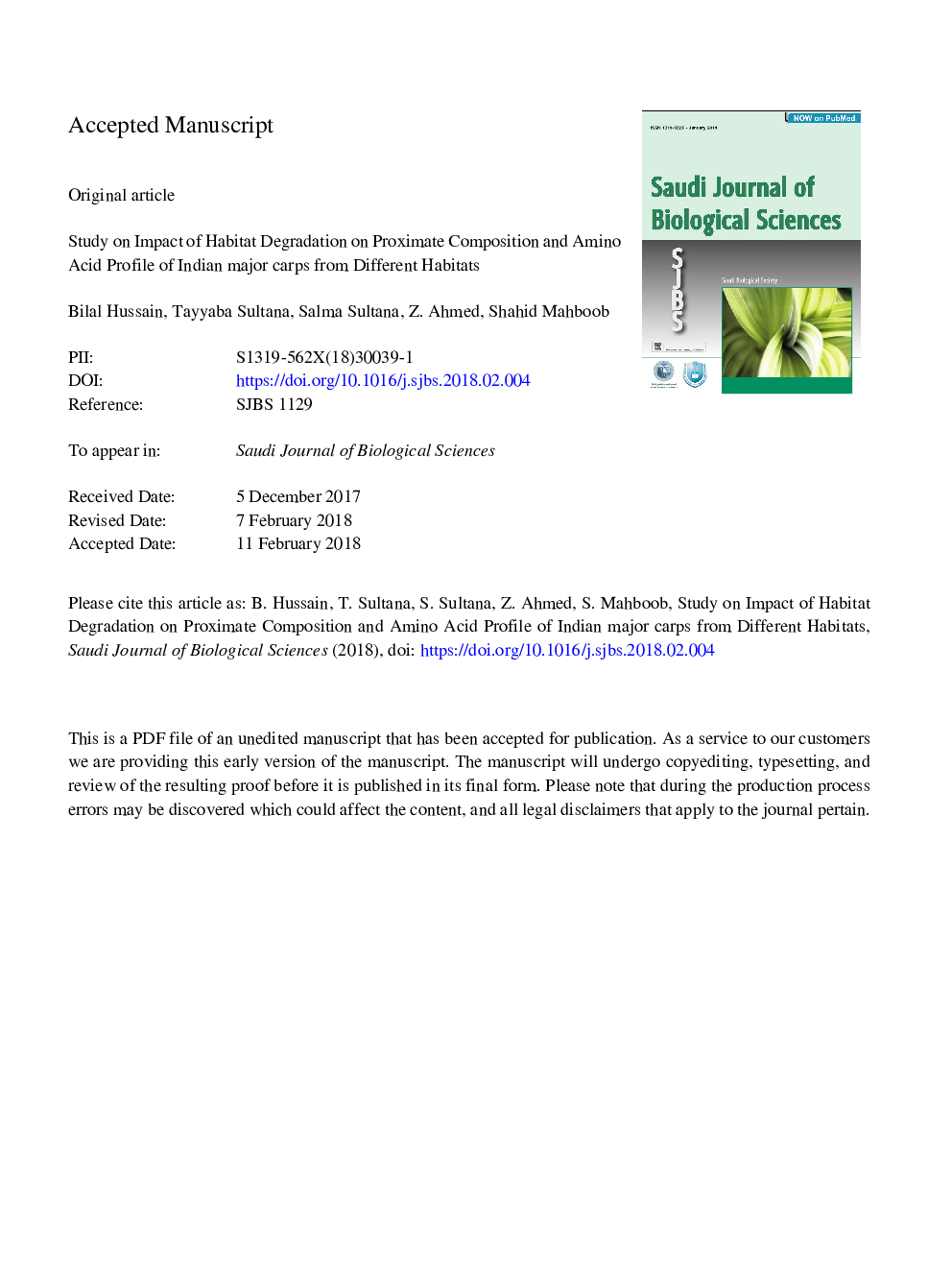| کد مقاله | کد نشریه | سال انتشار | مقاله انگلیسی | نسخه تمام متن |
|---|---|---|---|---|
| 8849794 | 1618657 | 2018 | 21 صفحه PDF | دانلود رایگان |
عنوان انگلیسی مقاله ISI
Study on impact of habitat degradation on proximate composition and amino acid profile of Indian major carps from different habitats
ترجمه فارسی عنوان
بررسی تأثیر تخریب زیستگاه بر ترکیبات نزدیکی و اسید آمینه اسید کاپورهای بزرگ هند از زیستگاه های مختلف
دانلود مقاله + سفارش ترجمه
دانلود مقاله ISI انگلیسی
رایگان برای ایرانیان
کلمات کلیدی
زیستگاه، آلودگی ماهی غیر آلوده، تجاری، آمینو اسید،
موضوعات مرتبط
علوم زیستی و بیوفناوری
علوم محیط زیست
بوم شناسی
چکیده انگلیسی
This investigation is aimed to study an impact of habitat degradation on proximate composition and amino acid (AAs) profile of Catla catla, Labeo rohita and Cirrhinus mrigala collected from polluted, non-polluted area (upstream) and a commercial fish farm. The amino acid profile was estimated by the amino acid analyzer. C. catla collected from the polluted environment had highest lipid, protein and ash contents (12.04â¯Â±â¯0.01, 13.45â¯Â±â¯0.01 and 0.93â¯Â±â¯0.03%, respectively). The high protein content (14.73â¯Â±â¯0.01 and 14.12â¯Â±â¯0. 01%) was recorded in C. catla procured from non-polluted (upstream) wild habitat of River Chenab and controlled commercial fish farm. Farmed fish species showed comparatively higher moisture contents followed by upstream and polluted area fishes. C. mrigala showed significant differences in amino acid and proximate composition collected from a polluted site of the river Chenab. C. catla collected from non-polluted site of the river showed an excellent nutrient profile, followed by L. rohita (wild and farmed) and C. mrigala (polluted area), respectively. All fishes from the polluted areas of the River Chenab indicated a significant decrease in the concentration of some AAs when compared to farmed and wild (upstream) major carps. Omitting of some important AAs was also observed in the meat of fish harvested from polluted habitat of this river. C. mrigala and L. rohita exhibited a significant increase in the concentration of some of non-essential amino acids such as cysteine in their meat. The results indicated that wild fish (upstream) and farmed fish species had highest protein contents and amino acid profile and hence appeared to be the best for human consumption. The proximate composition and AAs profiles of fish harvested from the polluted area of the river clearly indicated that efforts shall be made for the restoration of habitat to continue the requirement of high quality fish meat at a low cost to the human population.
ناشر
Database: Elsevier - ScienceDirect (ساینس دایرکت)
Journal: Saudi Journal of Biological Sciences - Volume 25, Issue 4, May 2018, Pages 755-759
Journal: Saudi Journal of Biological Sciences - Volume 25, Issue 4, May 2018, Pages 755-759
نویسندگان
Bilal Hussain, Tayyaba Sultana, Salma Sultana, Z. Ahmed, Shahid Mahboob,
